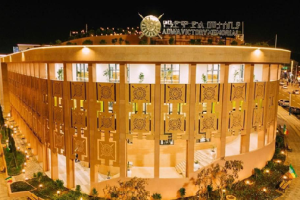It is not without tangible reason that in the tourist posters Ethiopia is often referred to as “The Land of Origins”. Ethiopia is the origin of many things including the human race with Lucy, coffee with Kaffa: the place of its birth, teff, or the grain super-food that has recently become an international dietary and medical sensation.
Ethiopia is the source of the Nile, which is one of the longest and powerful rivers in the world and the biggest in Africa on which it has built the biggest hydropower dam.
Last but not least, Ethiopia has been recently captivating international attention and grabbing the headlines for its discovery of another super-food called enset made from false banana and is found to be highly nutritious and easily cultivated on small plots of lands, which is ecological-friendly and resistant to droughts and natural calamities.
A super-food is defined as “a food (such as salmon, broccoli, or blueberries) that is rich in compounds (such as antioxidants, fiber, or fatty acids) considered beneficial to a person’s health,” according to the Merriam-Webster Dictionary.
The term “super-food” is a fairly new term referring to foods that offer maximum nutritional benefits for minimal calories. They are packed with vitamins, minerals, and antioxidants. According to scientists who have studied its nutritive properties, “the plant enset, an Ethiopian staple, could be a new super-food and a lifesaver in the face of climate change. The banana-like crop has the potential to feed more than 100 million people in a warming world, according to a new study.”
Ethiopia might also be the land of many still undiscovered or unknown plant and animal species that may be awaiting international recognition. The story of enset however is a still mysterious one for the simple reason that it is a plant that can feed as many people as possible when cultivated on small plots of lands and under any climatic conditions.
A recent piece of news in an international newspaper (the Daily Star) carried an explosive headline saying that, “False-banana Super-food from Ethiopia than can Feed the World”.
The story went on to say that, “Scientists in a new study revealed that the crop from the plant enset (Ensete ventricosum, say), a staple in Africa’s Ethiopia, could be a new super-food with the potential to feed over 100 million people – saving their lives amid the global warming induced climate change, reports BBC. The crop, largely unknown outside Ethiopia, is a close relative of banana and is often dubbed as “false banana” or “Ethiopian banana”.
The difference between false and true banana is fundamental, while appearances may be deceptive. The false banana looks exactly like a banana tree with big and flat green leaves; carrying tiny fruits that look somehow like bananas but are not true bananas.
On the surface or a glimpse of both trees gives the onlooker food for thought: why are the fruits of false banana are not giving the real bananas? while the stems and leaves go into the preparation of one of the most delicious food items in traditional Ethiopian specialties while a true banana tree gives only bananas that are equally edible and delicious to the taste and highly nutritious to the body.
The above news report further said that Ethiopians use the plant’s starchy rhizome and bulbs to produce porridge and a type of flat bread called “kocho”. Usually the plants, which can grow up to 39 ft, are cultivated in small plantations, but the research, published in Environmental Research Letters, suggests that enset may be grown over larger expanse of land in Africa.
“This is a crop that can play a really important role in addressing food security and sustainable development,” Dr Wendawek Abebe of Hawassa University in Ethiopia, told BBC. The enset plant looks quite similar to banana plants. The fruit of the plant also looks somewhat similar to banana but is inedible as those are full of seeds.
The edible parts of the plant are its starchy stems, bulbs and roots that can be fermented and used to make porridge and bread, according to the BBC report. Around 20 million people in Ethiopia rely on enset for food. It, however, is not cultivated anywhere else. Wild relatives are found as far as South Africa, but those are not considered edible.
What is interesting about enset is not only its nutritional value. According to the same report, “ the cultivation potentials of enset and revealed that it could feed more than 100 million people and enhance food security in Ethiopia and across much of Africa over the next four decades.” according to the recent study conducted on its potentials to feed many people as possible across Africa living in drought-prone regions, enset “may be planted as a buffer crop during lean times to boost food security as it can be planted and harvested any time of the year.”
According to another report, “Climate change is projected to severely affect the yield and distribution of essential food crops in Africa and other continents. Therefore, there is a growing interest in new plants that provide food, as humanity depends on some basic plants.
Nearly half of the calories consumed can be attributed to three crops: rice, wheat, and corn.” Enset will therefore be a welcome addition to these three crops with the difference that, while enset grows easily and output is abundant, the three crops listed above require much more investment and land to grow.
The most interesting part of the story may be the fact that enset possesses unusual characteristics because it can be planted at any time, harvested at any time and that it is perennial.
We may perhaps add by saying that enset can be one of the most potent foods against recurrent hunger in Ethiopia and in other regions of Africa. In fact, this is the main message of the story at this particular time when millions of people in East Africa or in the Horn are threatened with drought and hunger.
Maybe the discovery about the life-saving potentials of enset has come relatively late but not too late, because international food organizations like FAO and others can jointly launch an emergency program to start planting enset on a large scale in areas where food security is most burning issue and save many lives. Most of the work related to the task of developing enset as a lifesaving plant is already contained in the latest scientific discoveries.
It may be now up to agriculturalist to bring the discoveries to practical application in order to avert a potentially catastrophic food crisis and even famine in Africa. Emergency measures like the one taken to develop vaccines against COVID-19 should be urgently launched if the world wants to save countless lives to the threatening deadly drought and famine instead of spending billions of dollars on food aid later on.
Until very recently and even at this moment false banana trees were not the objects of interest to food specialists or dietitians both within the country and in the international fields of research in traditional African foods in general and Ethiopian dishes in particular.
One reason may be that false banana is growing in limited areas in south-western parts of Ethiopia inhabited by an ethnic group known as the Gurarage, famous for their hard working traditions as traders, who are living in a very fertile locality where the soil is red while the surrounding areas are covered with green vegetation, including false banana known is the local language as enset from which various kinds of kocho or circular and flat breads are made. The enset culture area covers wide areas with varying climatic conditions.
According to one study, “Cultivation of enset is mainly concentrated in the south and southwestern midland and highland parts of Ethiopia. In southern region it is a dominant staple food crop that covers approximately about 168,000 ha and is the main source of food for about 7-10 million people in the region.” The expansion of enset cultivating areas could be an easy task as the plant grows under different climatic conditions and requires a relatively smaller area to grow the crop that can feed more people.
Until recently enset or kocho served as staple foods only for the rural people in the Gurage zone where the plant has its origin. Kitfo is also a Gurage food specialty consisting of finely minced red meat that is served drenched in traditional butter and eaten with kocho the way Ethiopians eat injera with wot or sauce.
This is one of the most expensive and thus tastiest traditional dishes served in posh restaurants in major cities like Addis Ababa so much so that ordering kitfo has become synonymous with eating the best traditional food available by the meat-loving urban middles classes.
One proof of this is that the price of a dish of kitfo with kocho has gone very high over the last few years while demands for it are also growing steadily.
Many food connoisseurs maintain that paying as high as 400 or 500 birr for a small dish of kitfo is worth it. There are also many luxury restaurants in Addis that charge even more given the fact that the price of a kilogram of meat is nowadays beyond the purchasing capacity of most Ethiopians.
Even under the current food price hikes, many food lovers would go for a dish of kitfo on special occasions or on rare but ordinary days. Kocho without kitfo is not as expensive as when it is served with kitfo.
Most ordinary farers in Gurage zone survive on kocho and there has never been media report of hunger or food crisis in the area. Enset farmers maintain that the processed plant can be kept for many years in special holes dug under the ground. This is how they keep food reserves for lean years that are rare anyway.
According to a recent news report, ‘Ethiopia is the super-food of the future’. “In Ethiopia alone, which already has a population of 100 million, the distant relative of bananas feeds more than 20 million.
Enset would thrive in Kenya, Uganda and Rwanda, where they had never heard of it.” How many super-foods Ethiopia might have? Future research is bound to come up with many surprises.
BY MULUGETA GUDETA
The Ethiopian Herald March 25/2022





